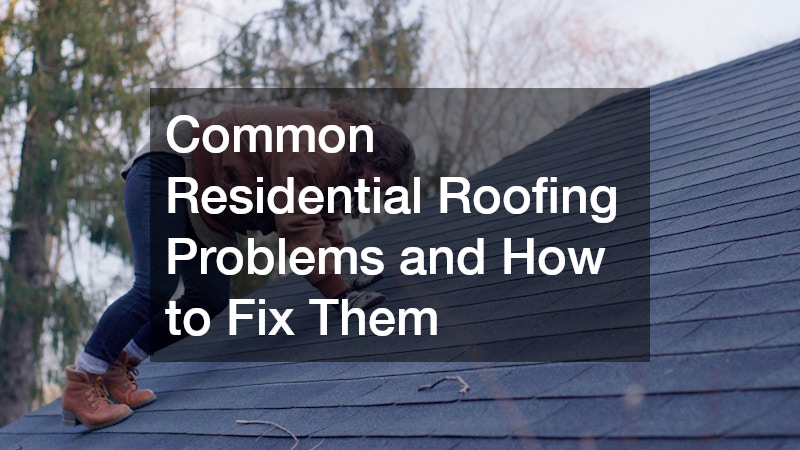A secure, well-maintained roof is one of the most vital components of any home. However, due to exposure to the elements and natural ageing, even the best-built roofs can experience wear and tear over time. Understanding the most common residential roofing problems—and how to address them—can help Australian homeowners protect their property, save on costly repairs and extend the life of their roofing system.
Leaks & Water Damage
Leaks are one of the most frequent issues with residential roofing, often stemming from damaged flashing, broken tiles or poor roof installation. Water intrusion can lead to rot, mould growth and ceiling damage if left unchecked.
Fix:
The best approach is to locate the source of the leak as early as possible, typically after heavy rainfall. Look for water stains on ceilings or walls, then trace them back to the roof. If the damage is minor, replacing cracked tiles or resealing flashing may suffice. For more extensive damage, consult a professional roofer to prevent further structural issues. Regular inspections, especially before and after storm season, are a proactive way to catch problems early.
Broken or Missing Tiles
In Australia’s varying climate, roofing tiles can crack or dislodge due to high winds, hail or shifting foundations. This not only affects your home’s aesthetics but also compromises the roof’s ability to repel water effectively.
Fix:
Inspect your roof regularly and after extreme weather events. Replace any broken or missing tiles as soon as possible. It’s important to use matching tiles and proper installation methods to maintain the integrity of the roof. For two-storey homes or steeper roofs, always engage licensed roofers to ensure safety and compliance with Australian building standards.
Blocked Gutters & Downpipes
Gutters and downpipes are designed to channel water away from your roof and home. When they’re clogged with leaves, debris or nesting materials, water can back up and pool, leading to leaks, rust and even foundational damage.
Fix:
Clean gutters at least twice a year—ideally in autumn and spring. Installing gutter guards can reduce the frequency of blockages and make maintenance easier. If you’re unsure about handling this task safely, hire a professional for seasonal cleaning and inspection.
Poor Roof Ventilation
Effective ventilation is crucial for regulating temperature and moisture levels in your roof cavity. Without it, condensation can form, leading to timber rot, mould and reduced insulation effectiveness, especially in hot Australian summers.
Fix:
If you notice a musty smell or increased humidity indoors, inspect your roof ventilation. Ensure soffit and ridge vents are clear and functioning. In some cases, installing additional vents or upgrading to mechanical ventilation may be necessary, particularly in older homes or high-humidity areas.
Sagging Roof Structure
Sagging indicates a serious structural problem, often caused by water damage, excessive weight (such as from accumulated debris or solar panels) or a weakened support frame.
Fix:
This is not a DIY issue. Call a qualified structural engineer or roofing professional immediately to assess the damage. Reinforcement, replacement of support beams or trusses and repairs to internal framing may be required. Early detection is crucial to avoid more extensive damage or roof collapse.
Roof Discolouration & Moss Growth
Discolouration, mould and moss don’t just affect curb appeal—they also signal potential moisture retention, which can degrade roofing materials and lead to leaks.
Fix:
Use a gentle pressure wash or a chemical moss treatment designed for tiled roofs. Avoid aggressive scrubbing or harsh chemicals, which can damage the roof surface. Applying a roof sealant can also inhibit future growth and extend the lifespan of your tiles.
Prevention Is Better Than a Cure

The key to avoiding costly roof repairs is regular inspection and maintenance. Most roofing issues develop slowly and are preventable with proactive care. Aim to check your roof at least twice annually and after severe storms, looking for signs of wear, water ingress or material deterioration.
Working with a trusted roofing specialist ensures your residential roofing remains in top condition. Professional roofers can provide expert evaluations, spot issues you might overlook and carry out repairs that comply with the Australian Building Code.
Whether your concern is a minor leak or a sagging structure, timely intervention is crucial. By staying informed and acting early, homeowners can protect their biggest asset and enjoy peace of mind, rain, hail or shine.
Final Tip: Always keep documentation of inspections and repairs. This not only helps track the health of your roof but can also be a valuable asset when selling your property.


